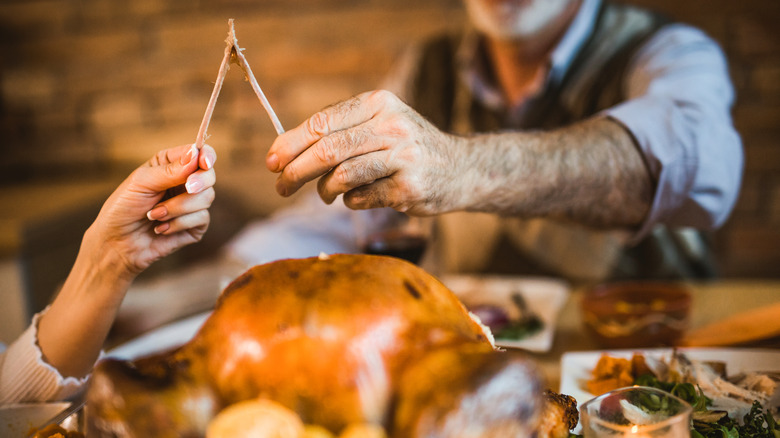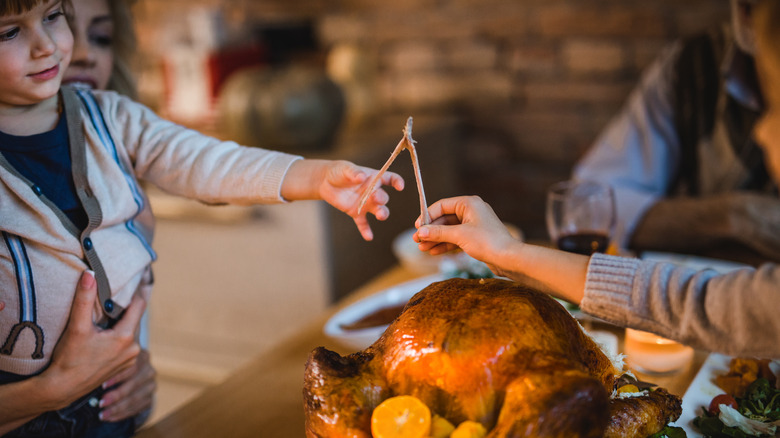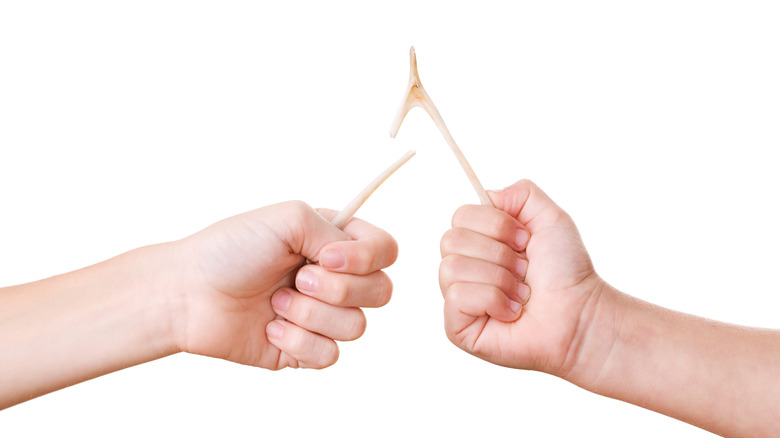The Poultry Wishbone Game Has Existed Since Ancient Times
If you've got a wish to make, forget the dandelions and turn to a tradition that's been sparking hopes since 800 B.C. — breaking the poultry wishbone. Thanksgiving is full of quirky traditions like this, from frozen turkey bowling to morning Turkey Trot runs. You might already be familiar with the wishbone custom, but you might not know it began with the Etruscans, an ancient Italian civilization. They believed chickens were tied to destiny and could predict the future. So, they'd lay out wishbones from deceased animals to dry in the sun, then touch them in hopes of swaying destiny in their favor.
Eventually, the tradition made its way to the Romans, who saw chickens as both fortune tellers and fine dining. For special occasions, they'd even fatten up the chickens with lizard fat for extra flavor. Rather than simply handling the wishbone, the Romans introduced a contest — two people would tug on it, and the one who ended up with the larger fragment was thought to have their wish fulfilled.
In the 15th century, the British adopted this tradition for Michaelmas, a feast marking the end of the agricultural season on September 29. Instead of chicken, they used the wishbone from geese, which were considered at their prime in autumn, after they'd fed on post-harvest grain left in the fields. Eating the fattened goose was a ritual for ensuring good fortune, believed to protect against financial hardship in the coming year. Over the centuries, various forms of poultry-related folklore and customs merged with the wishbone tradition. By the 19th century, the custom became a fixture on American Thanksgiving tables — a holiday for gratitude, and perhaps a little wish-making too.
How to prepare your turkey wishbone for Thanksgiving
So, you've decided to conjure up some Thanksgiving magic this year using Fred (or whatever name you've given your turkey) along with all the ancestral wish energy he brings. Before you jump into the wish-making, there are a few key things to know about preparing the bone. First, you'll need to remove it. Pro tip: Cut it out before roasting your turkey to make carving easier later. The wishbone is located at the top of the bird, near the neck cavity, and it can be tricky to work around if left in during cooking. This is why chefs in culinary school do it this way — even when they're not making wishes.
Before you start fighting over the wishbone, there's one more important step — drying it. Traditionally, this takes a few days, but if you're feeling impatient (or just really need that wish), pop it in the oven for a few minutes and fast-track the magic. A dry, brittle bone is what gives you that satisfying snap.
Tips for winning the wishbone showdown
Once you've got your wishbone dried and ready, it's time for the ultimate showdown. Much like the Romans did it, the modern American game has two people each grab one side of the wishbone, make a silent wish, and pull until it snaps. Whoever ends up with the larger piece is said to have their desire granted.
Now, if you're looking to increase your chances of winning this ancient contest, here's a smart strategy: Grab the thicker side of the bone, as it's less likely to break under pressure. Also, try to grip as close to the joint as possible (where the two sides meet) to give yourself more control and prevent a quick snap. But whether you win or lose, just remember — it's Thanksgiving, and gratitude is always the real prize! Plus, you've got a delicious feast waiting to be enjoyed (and for the non-cooks, Trader Joe's has a heat-and-eat Thanksgiving meal just for you).


